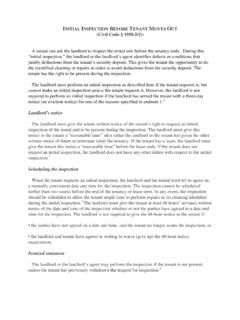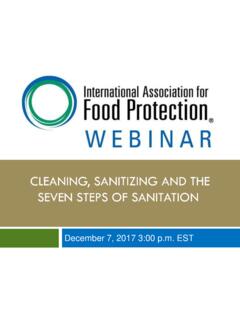Transcription of OSHA Self-Inspection Checklist - EHSO
1 OSHA Self-Inspection Checklist From (revised 2017) Page 1 of 27 Self-Inspection Checklists This is the most recent Self-Inspection Checklist produced by OSHA, as part of their Small Business Handbook series. These checklists are by no means all-inclusive; but they are an excellent You should add to them or cross out portions or items that do not apply to your operations; however, carefully consider each item as you come to it and then make your decision. You will also need to refer to OSHA standards for complete and specific standards that may apply to your situation. (NOTE: These checklists are typical for general industry but not for construction or maritime.) Contents Administrative and General Requirements .. 2 SAFETY AND HEALTH PROGRAM .. 2 PERSONAL PROTECTIVE EQUIPMENT.
2 4 FLAMMABLE AND COMBUSTIBLE MATERIALS .. 8 HAND AND PORTABLE POWERED TOOLS .. 11 Hand Tools and Equipment .. 11 Portable (Power Operated) Tools and Equipment .. 12 Powder-Actuated 13 LOCKOUT/TAGOUT PROCEDURES .. 14 CONFINED SPACES .. 16 ELECTRICAL .. 18 WALKING-WORKING SURFACES .. 21 General Work Environment .. 21 Walkways .. 21 Floor and Wall Openings .. 22 Stairs and Stairways .. 23 Elevated Surfaces .. 24 HAZARD COMMUNICATION .. 26 Does this program include: .. 27 Are employees trained in the following:.. 27 OSHA Self-Inspection Checklist From (revised 2017) Page 2 of 27 Administrative and General Requirements Yes No Requirement Regulations Do you have more than 10 employees? If "Yes": Do you have a written Emergency Contingency Plan? 29 CFR outlines the requirements for an emergency contingency plan for those who employ more than 10 at any one time during the year.
3 Is your Form 200 up-to- date and posted Feb 1 for 30 days? 29 CFR 1904 requires that employers of more than 10 at any one time in the year maintain occupational illness and injury reports on Form 101 or equivalent and summarize them on Form 200 which is posted each Feb. 1 for 30 days. SAFETY AND HEALTH PROGRAM Yes No Requirement Regulations Written Hazard Communication Plan Do you have an active safety and health program in operation that deals with general safety and health program elements as well as management of hazards specific to your worksite? Employers must have a written plan which describes how the training, labeling, MSDS management and other requirements of "Right-to-Know" will be met. 29 CFR Responsibility assigned to a specific person for the safety program?
4 Is one person clearly responsible for the overall activities of the safety and health program? 29 CFR (and other regulations) require that you assign responsibility for the many aspects of the safety program. Some states also specifically require that employers name a OSHA Self-Inspection Checklist From (revised 2017) Page 3 of 27 Yes No Requirement Regulations person for responsibility with overall safety. Do you have a safety committee or group made up of management and labor representatives that meets regularly and reports in writing on its activities? Employee complaints Do you have a working procedure for handling in-house employee complaints regarding safety and health, such as unguarded equipment, safety procedures not being followed, or medical issues, such as headaches, nausea, dizziness or skin problems?
5 All OSHA standards require that employers evaluate workplace hazards and determine whether operational conditions, material use or employee complaints mean that there is any exposure to unsafe conditions. Are you keeping your employees advised of the successful effort and accomplishments you and/or your safety committee have made in assuring they will have a workplace that is safe and healthful? Have you considered incentives for employees or workgroups who have excelled in reducing workplace injuries/illnesses? Formal disciplinary policy/procedure relating to safety Rules that are not enforced are often not followed. OSHA requires employers enforce safety rules. OSHA Self-Inspection Checklist From (revised 2017) Page 4 of 27 PERSONAL PROTECTIVE EQUIPMENT Yes No Requirement Regulation Are employers assessing the workplace to determine if hazards that require the use of personal protective equipment (for example, head, eye, face, hand, or foot protection) are present or are likely to be present?
6 If hazards or the likelihood of hazards are found, are employers selecting and having affected employees use properly fitted personal protective equipment suitable for protection from these hazards? Has the employee been trained on ppe procedures, that is, what ppe is necessary for a job task, when they need it, and how to properly adjust it? Are protective goggles or face shields provided and worn where there is any danger of flying particles or corrosive materials? Are approved safety glasses required to be worn at all times in areas where there is a risk of eye injuries such as punctures, abrasions, contusions or burns? Are employees who need corrective lenses (glasses or contacts) in working environments having harmful exposures, required to wear only approved safety glasses, protective goggles, or use other medically approved precautionary procedures?
7 Are protective gloves, aprons, shields, or other means provided and required where employees could be cut or where there is reasonably anticipated exposure to corrosive liquids, chemicals, blood, or other potentially infectious materials? See 29 CFR OSHA Self-Inspection Checklist From (revised 2017) Page 5 of 27 Yes No Requirement Regulation (b) for the definition of "other potentially infectious materials." Are hard hats provided and worn where danger of falling objects exists? Are hard hats inspected periodically for damage to the shell and suspension system? Is appropriate foot protection required where there is the risk of foot injuries from hot, corrosive, or poisonous substances, falling objects, crushing or penetrating actions? Are approved respirators including dusk masks provided for regular or emergency use where needed?
8 If so, are there written respirator procedures? 29 CFR requires that if any employee uses a respirator, including a dust mask, written procedures must cover use, fit testing, cleaning and maintenance of the respirator. Do you have records showing fit testing of respirators and training? 29 CFR requires employers to test the fit of each respirator on each employee and train the employee to check and properly use the respirator. Is all protective equipment maintained in a sanitary condition and ready for use? Do you have eye wash facilities and a quick drench shower within the work area where employees are exposed to injurious corrosive materials? Where special equipment is needed for electrical workers, is it available? Where food or beverages are consumed on the OSHA Self-Inspection Checklist From (revised 2017) Page 6 of 27 Yes No Requirement Regulation premises, are they consumed in areas where there is no exposure to toxic material, blood, or other potentially infectious materials?
9 Is protection against the effects of occupational noise exposure provided when sound levels exceed those of the OSHA noise standard? Are adequate work procedures, protective clothing and equipment provided and used when cleaning up spilled toxic or otherwise hazardous materials or liquids? Are there appropriate procedures in place for disposing of or decontaminating personal protective equipment contaminated with, or reasonably anticipated to be contaminated with, blood or other potentially infectious materials? Can you reasonably anticipate that any employees will be exposed to human blood this year because of their jobs?Have you assigned responsibility for first-aid to an employee?If "Yes": Do you have written Bloodbourne Pathogen Exposure Control Plan?Have employees been trained in protective equipment and procedures?
10 29 CFR requires that employers develop an Exposure Control Plan, train employees, keep records, and offer Hepatitis B vaccinations if it can be reasonably anticipated that one or more employees could be exposed to human blood or blood products as a result of doing their assigned duties. If you have assigned first aid responsibilities to an employee you are required to have a Bloodborne Pathogen OSHA Self-Inspection Checklist From (revised 2017) Page 7 of 27 Yes No Requirement Regulation Program. Special waste management and use of approved disinfectants are also required. The key is "reasonable anticipation". Good Samaritan acts are not covered. INFECTIOUS AND BLOOD BORNE PATHOGENS Yes No Requirement Regulation Can you reasonably anticipate that any employees will be exposed to human blood this year because of their jobs?




